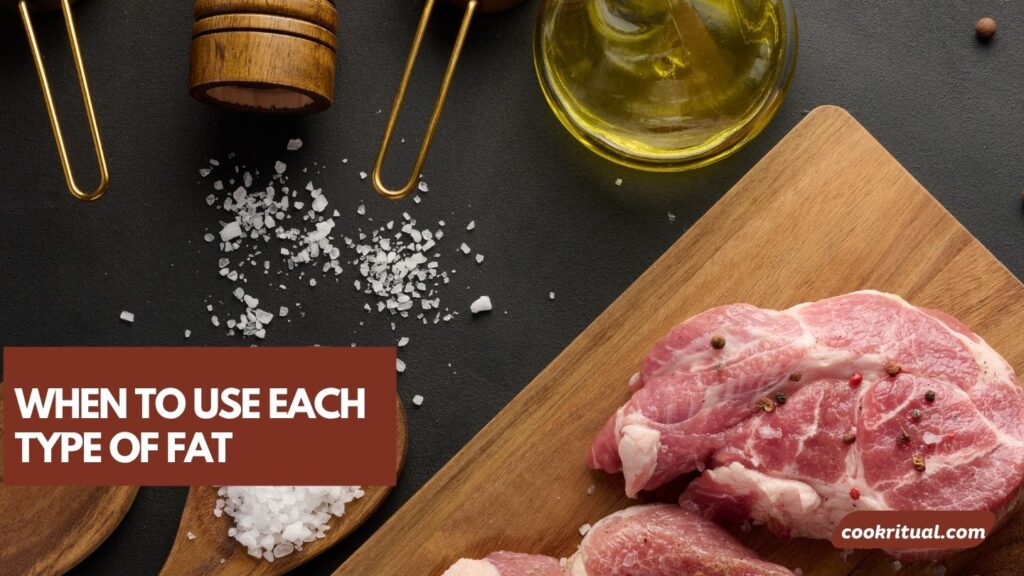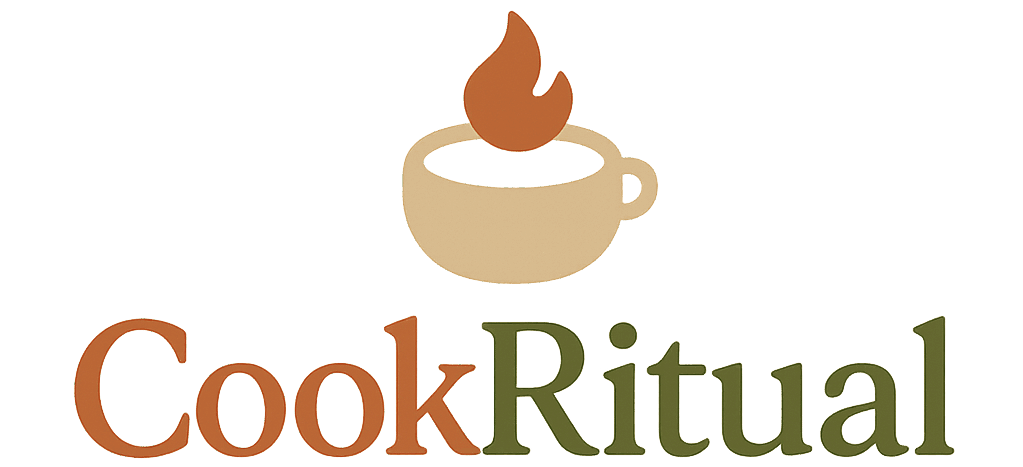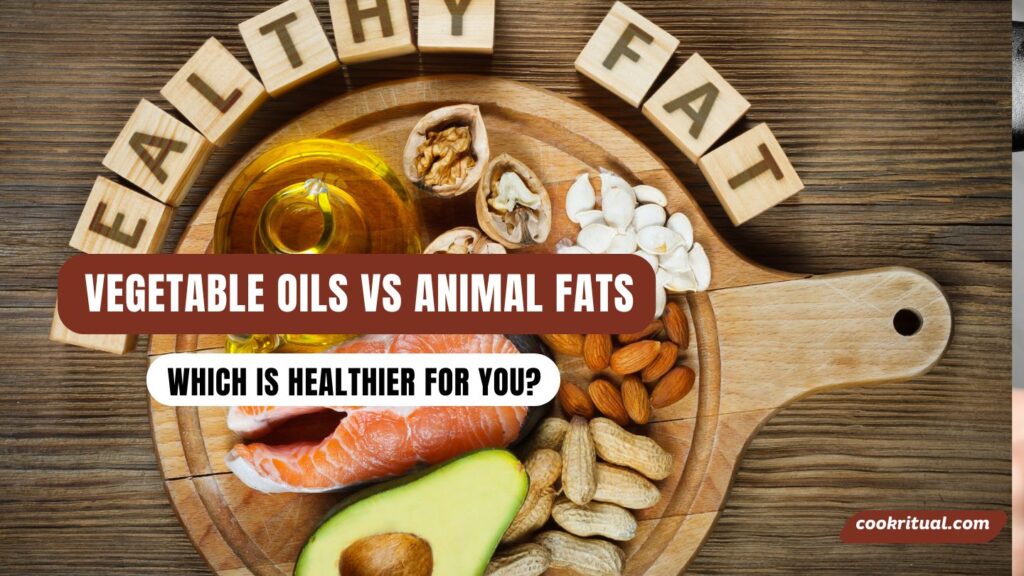Both vegetable oils and animal fats can be part of a healthy diet—but the key is knowing when, how, and which to use.
In recent years, dietary fats have been at the center of heated debates in kitchens and nutrition circles alike. One side praises plant-based oils for their heart-healthy benefits, while the other defends traditional animal fats for their stability and flavor. With so many mixed messages online and on product labels, it’s no wonder people are confused.
So, what’s actually better for our health: vegetable oils or animal fats? And how do we decide which fat to reach for when cooking dinner, meal prepping for the week, or baking family favorites?
In this guide, we’ll walk through the science, the practical uses, and the pros and cons of both fat types. Whether you’re sautéing veggies, deep frying chicken, or following a specific diet like keto or heart-healthy eating, you’ll find clear, practical advice to help you choose the right fat every time.
Contents
- 1 2. Understanding the Basics of Fats
- 2 3. Vegetable Oils Explained
- 3 4. Animal Fats Explained
- 4 5. Head-to-Head: Vegetable Oils vs Animal Fats
- 5 6. When to Use Each Type of Fat
- 6 7. Buying and Storing Fats
- 7 8. Expert Tips and Practical Recommendations
- 8 9. FAQs: What People Are Asking
- 9 10. Conclusion: What’s the Healthiest Fat for You?
2. Understanding the Basics of Fats
2.1 What Are Fats and Why Do We Need Them?
Fats are one of the three main nutrients our bodies need, along with carbohydrates and protein. They give us energy, support cell function, and help us absorb vitamins like A, D, E, and K.
Fat also plays a role in brain health, hormone production, and keeping us full after meals. While fats once had a bad reputation, many types are actually essential for good health. The key is choosing the right kind in the right amount.
According to Harvard Health, not all fats are equal. Some types can raise cholesterol and increase disease risk, while others protect your heart and brain.
2.2 Saturated vs Unsaturated Fats: What’s the Difference?
Let’s break down the two main types of fat you’ll see in foods: saturated fats and unsaturated fats.
- Saturated fats are solid at room temperature. You’ll find them in butter, lard, and fatty cuts of meat. They’ve been linked to higher levels of LDL (“bad”) cholesterol when eaten in large amounts.
- Unsaturated fats are liquid at room temperature. They’re mostly found in plant-based oils, nuts, seeds, and fish. These fats help lower LDL and raise HDL (“good”) cholesterol.
There are two types of unsaturated fats:
- Monounsaturated fats – Found in olive oil, avocados, and nuts.
- Polyunsaturated fats – Found in sunflower oil, flaxseed, and fatty fish.
Replacing saturated fats with unsaturated ones can reduce heart disease risk, according to the American Heart Association.
3. Vegetable Oils Explained

3.1 Common Types of Vegetable Oils
There are many vegetable oils on the market, and each has its own benefits, flavor, and best use. Here’s a quick comparison to help you decide which oil fits your needs:
| Oil Type | Smoke Point (°F) | Omega-3/6 Ratio | Best Use |
| Olive Oil | 375–410 | Low omega-6 | Dressings, sautéing |
| Canola Oil | 400 | Balanced | Baking, light frying |
| Sunflower Oil | 440–475 | High omega-6 | High-heat cooking |
| Avocado Oil | 520 | Low omega-6 | Grilling, roasting |
| Soybean Oil | 450 | High omega-6 | Frying, processed foods |
Source: USDA FoodData Central
These oils are all plant-based and naturally cholesterol-free. They’re often promoted for their heart-friendly unsaturated fat content, especially monounsaturated and polyunsaturated fats.
3.2 Pros and Cons of Vegetable Oils
Pros:
- High in healthy unsaturated fats.
- Often enriched with vitamin E and omega-3s.
- Light flavor works well in many recipes.
- Most are affordable and easy to find.
Cons:
- Some oils are heavily processed or refined.
- High omega-6 levels in oils like soybean or corn may promote inflammation if consumed in excess, according to Cleveland Clinic.
- Many vegetable oils break down under high heat, which may create harmful compounds.
For best results, look for oils that are cold-pressed, unrefined, and stored in dark bottles.
4. Animal Fats Explained
4.1 Common Types of Animal Fats
Animal fats have been used in traditional cooking for centuries. They’re rich in flavor and work well in high-heat recipes. Here are the most common ones:
- Butter – Made from cream; popular in baking and sautéing.
- Lard – Rendered pork fat; used for frying or pie crusts.
- Tallow – Rendered beef fat; great for deep frying or roasting.
- Duck fat – A gourmet fat with a silky mouthfeel and savory flavor.
- Ghee – Clarified butter used in Indian and keto cooking.
These fats are naturally high in saturated fat, but some, like ghee, are rich in vitamins A and D.
4.2 Pros and Cons of Animal Fats
Pros:
- Naturally stable at high heat, making them ideal for frying.
- Adds deep flavor and rich texture to dishes.
- Traditional sources like pasture-raised lard or grass-fed butter may offer more nutrients, including CLA and fat-soluble vitamins.
Cons:
- High in saturated fat, which may raise LDL cholesterol if eaten in large amounts, as noted by the Mayo Clinic.
- Some people avoid them for ethical, religious, or environmental reasons.
- Can spoil faster if not stored properly.
When choosing animal fats, it’s smart to opt for organic or grass-fed options when available. These usually have a better nutrient profile and fewer additives.
5. Head-to-Head: Vegetable Oils vs Animal Fats
5.1 Nutritional Comparison Table
Here’s a side-by-side look at common vegetable oils and animal fats to help you make smart cooking choices:
| Type | Saturated Fat | Unsaturated Fat | Omega-3/6 Ratio | Smoke Point (°F) | Best Use |
| Olive Oil | Low | High (monounsaturated) | Good (low omega-6) | 375–410 | Dressings, sautéing |
| Canola Oil | Low | High (monounsaturated) | Balanced | ~400 | Baking, light frying |
| Butter | High | Low | Poor | 300–350 | Baking, flavor base |
| Lard | High | Moderate | Poor | ~370 | Frying, roasting |
| Avocado Oil | Low | High (monounsaturated) | Good | ~520 | High-heat grilling |
| Tallow | High | Low | Poor | ~400 | Deep frying, searing |
Source: USDA FoodData Central
This table shows that while vegetable oils often win in unsaturated fats, animal fats are more heat-stable and add deeper flavor.
5.2 Health Impacts: Cholesterol, Heart Disease, and Inflammation
Fats affect more than flavor—they impact heart health too. Diets high in unsaturated fats from sources like olive and avocado oil can help lower LDL (“bad”) cholesterol and support heart health. These fats also reduce inflammation.
On the other hand, eating too much saturated fat, found in butter and lard, may raise LDL cholesterol. That’s why the American Heart Association recommends limiting saturated fat to less than 10% of daily calories.
But it’s not just about cholesterol. Balance matters. Some traditional fats like ghee may have anti-inflammatory compounds like CLA. Meanwhile, some vegetable oils high in omega-6 (like soybean oil) can increase inflammation if eaten too often, especially without enough omega-3s to balance it out.
5.3 Environmental and Ethical Considerations
Choosing fats isn’t just a health decision—it’s also about sustainability. Vegetable oils, especially palm oil, can lead to deforestation and habitat loss if not sourced responsibly. Look for sustainable or RSPO-certified palm oil.
Animal fats, especially from factory farms, raise concerns about animal welfare, greenhouse gas emissions, and antibiotic use. However, using rendered fats from already-slaughtered animals can reduce waste.
Some consumers prefer plant-based oils for ethical or vegan reasons. Others favor pasture-raised animal fats for their traditional, whole-food quality.
6. When to Use Each Type of Fat

6.1 Best Fat for Frying, Baking, and Sautéing
Different fats shine in different cooking methods. Here’s a quick guide:
- Frying: Choose high smoke point fats like avocado oil, tallow, or peanut oil.
- Baking: Butter adds flavor, while canola oil gives a moist crumb.
- Sautéing: Olive oil works well for low to medium heat.
- Roasting: Duck fat or avocado oil adds a crispy texture.
Using the right fat helps avoid burning and brings out the best taste and texture in your dish. You can check Smoke Point Charts to match the fat to your method.
6.2 Taste and Texture Considerations in Recipes
Fats change how food tastes and feels:
- Butter gives baked goods a rich, comforting flavor.
- Lard or duck fat makes flaky pie crusts and crispy potatoes.
- Olive oil adds a smooth, peppery note to dressings and dips.
- Refined oils like canola are neutral and won’t affect the flavor.
Using fat as a flavor tool is part of what makes great home cooking.
6.3 Dietary Fit: Keto, Paleo, Vegan, Heart-Healthy Diets
Choosing fats depends on your dietary goals:
- Keto & Paleo: Favor animal fats, ghee, avocado oil, coconut oil.
- Vegan or Plant-Based: Stick with olive, avocado, canola, or nut oils.
- Heart-Healthy Diets: Focus on olive oil, canola oil, and limit saturated fats.
Each eating style calls for different fat types. The Dietary Guidelines for Americans also support limiting trans and saturated fats while encouraging unsaturated ones.
7. Buying and Storing Fats
7.1 How to Choose High-Quality Fats and Oils
Here are tips to shop smarter:
- Look for cold-pressed or expeller-pressed oils.
- Choose unrefined oils for dressings and refined ones for high-heat cooking.
- Pick organic, grass-fed, or pasture-raised animal fats if available.
- Avoid hydrogenated oils with trans fats, which are harmful to heart health (FDA).
Reading labels is key. Watch out for long ingredient lists and chemical-sounding names.
7.2 Storage Tips to Prevent Rancidity
Fats can go bad if not stored right. Here’s how to keep them fresh:
- Store oils in dark, cool places away from heat and light.
- Use dark glass bottles for olive or flaxseed oil.
- Keep animal fats like butter or lard in the fridge or freezer.
- Always seal containers tightly to avoid oxidation.
Fresh fat means better taste and better health. If your oil smells “off” or tastes bitter, it may be rancid—time to toss it.
8. Expert Tips and Practical Recommendations
8.1 How to Balance Fat Intake for Health
- Aim to get most of your fats from unsaturated sources like olive oil, avocado oil, nuts, and seeds.
- Limit saturated fats like butter and lard to occasional use, especially if you have high cholesterol or heart disease risk.
- Try swapping out heavy cream or butter in recipes for lighter oils or plant-based fats.
- Include fatty fish or omega-3 rich plant foods like flaxseed to balance omega-6 intake.
8.2 Cooking Tips to Maximize Fat Benefits
- Use stable fats like avocado oil or animal fats for high-heat cooking to avoid harmful breakdown products.
- Add delicate oils like extra virgin olive oil after cooking for best flavor and health benefits.
- Store fats properly to maintain freshness and avoid rancidity.
8.3 Simple Swaps to Improve Your Meals
- Swap butter with olive oil in salad dressings and sautéing.
- Use avocado oil or ghee instead of vegetable oil for roasting.
- Replace heavy cream with coconut milk or nut-based creamers.
9. FAQs: What People Are Asking
Q1: Are vegetable oils better than animal fats for heart health?
Vegetable oils high in unsaturated fats generally support heart health more than saturated animal fats. However, balance and quality matter.
Q2: Can I use animal fats if I’m on a vegan diet?
No, animal fats come from animals and are not vegan-friendly. Plant oils are the best choice for vegan diets.
Q3: What is the best oil for high-heat cooking?
Oils with high smoke points like avocado oil, refined sunflower oil, or animal fats like lard and tallow work best.
Q4: Are all vegetable oils unhealthy?
No, many vegetable oils like extra virgin olive oil and avocado oil are very healthy. Avoid heavily processed oils with trans fats.
10. Conclusion: What’s the Healthiest Fat for You?
Choosing between vegetable oils and animal fats depends on your cooking needs, health goals, and taste preferences. Most experts agree that focusing on quality, balance, and variety is key.
Using heart-healthy vegetable oils like olive or avocado oil regularly while enjoying animal fats like butter or lard in moderation creates a balanced and flavorful diet.
Remember, no single fat is perfect for all uses. Knowing their strengths helps you cook delicious meals that also support your health.
Ready to cook smarter and eat healthier? Try swapping your usual fats today and see the difference.

